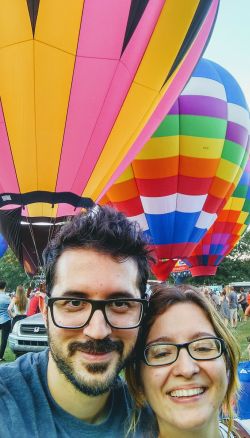5 Questions with Faculty: Charalampos Chelmis
ALBANY, N.Y. (Feb. 15, 2018) – Charalampos Chelmis is an assistant professor in the Department of Computer Science, part of the College of Engineering and Applied Sciences. Known as Harris, Chelmis was born in Greece, where he did his undergraduate work in computer engineering and informatics before moving to California to work on his masters and doctorate degrees. |
|
Charalampos Chelmis and his wife, Daphney-Stavroula Zois, both faculty in the College of Engineering and Applied Sciences, enjoy the sights at the Adirondack Balloon Festival last September.
|
At the University of Southern California (USC), Chelmis set his sights on a career in academic research.
“After completing my PhD on online social network modeling and analysis in 2013, I considered it a natural fit to grow as a postdoctoral researcher at USC,” he said. “I joined UAlbany, which I think of as the next logical step for my academic career in Fall 2016; UAlbany is a great place to achieve my research independence and become a world-renown expert in Big Data and Network Science.
A UAlbany, Chelmis is director of the Intelligent Big Data Analytics, Applications, and Systems (IDIAS) Lab. IDIAS conducts cutting-edge research in the intersection of network science, data mining, machine learning and data integration, working toward solving problems involving networked data application domains such as online social networks and the so-called “internet of things.”
What are you working on now?
Engineering a better world! What this really boils down to is 1. designing novel Network Science capabilities to support meaningful understanding of social behavior by leveraging Big Data; 2. summarizing Big Data for near-real-time decision making, and 3. translating theory to practice to advance the public good, with applications ranging from social work and urban analytics to cybercrime and public health.
What made you decide to pursue your field?
I was always fascinated by astrophysics and the way it employs the principles of physics to ascertain the nature, behavior, and interactions of the heavenly bodies. In many ways social networks behave as planets and stars, and this is where graphs (those “strange” mathematical structures used to model pairwise relations between objects) come into picture. Everything can be represented as a graph in my mind, and hence, my fascination with Big Networked Data.
What’s your favorite class to teach?
ICSI 432/532. It’s about Network Science, which I love! But also, it’s also my favorite because of the quite interesting mix of graduate and undergraduate students that make up this class, their experiences and opinions, their enthusiasm and energy, as well as their refreshing out-of-the-box thinking about how data all around us can be abstracted and studied as networks.
Who is someone who influenced you?
My wife, Daphney-Stavroula Zois, also a faculty of the College of Engineering and Applied Sciences. She is my “hidden figure” so to speak. She is the one who persuaded me to apply for a PhD in the first place. She is also the one who I look up to in terms of her determination to tackle problems that really matter. Academic curiosity is great but we always need to remember to step back and ask ourselves about the real-world applicability and impact of the theory and technology we develop.
What’s one thing students might be surprised to know about you?
I was member of a Greek folk dance performance group in my youth. Greek dance (called “horos” in Greek) is a very old tradition, being referred to by authors including Plato and Aristotle. Because of the many islands surrounding the Greek mainland, a plethora of choreographies and styles have been developed. I have learned quite a few of these and to this day I can adequately perform dances including the very famous sirtaki dance or “the dance of Zorba” (known from the 1964 film Zorba the Greek).
![]() For more news, subscribe to UAlbany's RSS headline feeds
For more news, subscribe to UAlbany's RSS headline feeds
A comprehensive public research university, the University at Albany-SUNY offers more than 120 undergraduate majors and minors and 125 master's, doctoral and graduate certificate programs. UAlbany is a leader among all New York State colleges and universities in such diverse fields as atmospheric and environmental sciences, business, education, public health,health sciences, criminal justice, emergency preparedness, engineering and applied sciences, informatics, public administration, social welfare and sociology, taught by an extensive roster of faculty experts. It also offers expanded academic and research opportunities for students through an affiliation with Albany Law School. With a curriculum enhanced by 600 study-abroad opportunities, UAlbany launches great careers.


